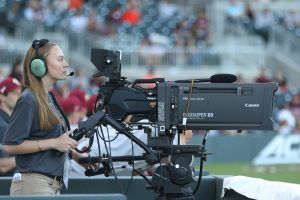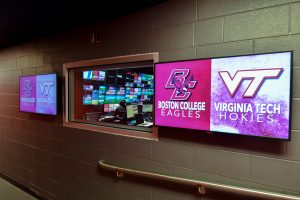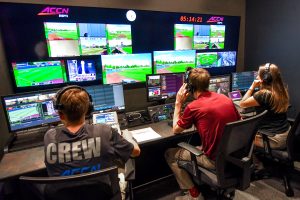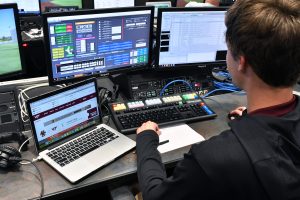Virginia Tech’s Lane Stadium Becomes Epicenter of HokieVision’s ACC Network Operations
In preparation for network launch, on-campus athletic venues received 96 strands of fiber each for connectivity
Story Highlights
As we sit on the doorstep of August, the summer is starting to heat up in the Atlantic Coast Conference (ACC). With about three weeks separating the 15 member institutions from the launch of the ACC Network, production teams from as far north as New York and as far west as Kentucky are polishing their facilities to live up to the hype. In the conference heartland, Virginia Tech’s HokieVision flipped the June Oblinger Shott Media Center in the south endzone of Lane Stadium and constructed two control rooms for the university’s network operations.
“The upcoming ACC Network and our buildout provide a national platform to expose our student athletes and their stories to as many eyes as possible,” says Eric Frey, senior director, ACC Network operations, Virginia Tech. “We have a lot of international student-athletes as well — especially on our soccer teams, from Canada and Europe. Our broadcasts are available in those areas, so it’s going to be a really nice way to attract potential student-athletes and expose the brand of Virginia Tech to more people.”
On the Road Again: Fellow ACC, SEC Colleagues Open Their Doors
After the likelihood of the network became concrete three years ago, Frey and company got by with a little help from their friends during the initial stages. Some calls to universities that had gone through a similar process with ESPN resulted in an old-fashioned road trip to numerous campuses, including the University of Tennessee and Liberty University, in early 2017.
“Who we selected [to visit] was important because each of these schools is unique due to resources or finances,” says Brian Walls, assistant athletic director, ACC Network operations, Virginia Tech. “You can go from one school to the next and see that they had more of a mindset in doing studio productions and spent their budget on areas that weren’t necessarily functional from a network perspective but could help them in recruiting.”
Throughout this makeshift tour of the college circuit, production philosophies, techniques, and tidbits were cherrypicked from each site and blended into the concepts behind Virginia Tech’s construction.
“[For example], we went to the University of Tennessee because it was close to us, and we saw some cool ideas that they were using [on the SEC Network]. They had a budget that they spent more towards their studio set, and, while we were doing the walkthrough, we saw four or five recruits,” says Walls. “We were told to look at [the University of] South Carolina because they were geared towards doing more broadcasts. We went to [the University of] Missouri because they [constructed their space] on a limited budget and do a great job. [Duke University Executive Director, Blue Devil Network] Chad Lampman was the first in the conference to take a shot at the linear control room, and they’ve been very open at letting anyone come in to take a look at what they’ve done. We took a piece from all of the places that we visited and applied it to our buildout.”
Fibered Network Extends Across All Campus Venues
After the team returned from its tour, Angie Littlejohn, senior associate athletic director, internal operations, Virginia Tech, spearheaded the administrative efforts that produced an approved budget of $10 million.
Demolition and renovation of the selected location got started in May 2018 and wrapped up in January 2019. Virginia Tech chose Atlanta-based Comprehensive Technical Group (CTG) as the systems integrator. Unlike with the prior setup, laying down an ample amount of fiber was at the top of the list. In the current configuration, each of the six on-campus venues — English Field at Atlantic Union Bank Park (baseball), Tech Softball Park (softball), Thompson Field (soccer/lacrosse), Cassel Coliseum (basketball/volleyball/wrestling), and control rooms in The Merryman Center — received 96 strands of fiber connecting to the nucleus in Lane Stadium.
“The infrastructure that we had before was not necessarily planned out well in advance,” says Walls. “A lot of that was the limitation of there not being a budget to get the fiber infrastructure to wherever it needed to be. We were patching it all together as best as we could. This new facility is a significant upgrade across the board for our entire department: not just with the ACC Network and what used to be the ESPN3 platform for us but also from a videoboard-show perspective. We’re able to do and have things now — like cameras, positions, and resources — that we were never able to do. It’s really a game-changer for us.”
The thorough network of fiber is one highlight of the renovation, but the meat-and-potatoes of the operation is the technology housed in the Media Center. Led by Sam Jones, chief engineer, Virginia Tech, the broadcast engineers assembled a plan that could accommodate multiple productions at once. The headliners include an Evertz EQX router, multiple Evertz DreamCatcher replay servers, and six remote-control panels/playout machines with 24 inputs that can tap into any venue for shared resources. For each broadcast, HokieVision leverages ChyronHego’s Sports FX engine and its array of graphics applications, including Paint telestrator and Virtual Placement ad insertion. In the field, the altruistic mentality continues with a complement of 16 shared cameras that include Ikegami HDK-99’s and UHK-430’s as an HDR option. These cameras are outfitted with Canon DigiSuper 80X and 95X lenses.
Although the two control rooms, offices for ACC Network staff, and edit suites are complete, there is still additional work to further improve the production quality of Virginia Polytechnic Institute and State University.
“The outstanding items that we have are just a few venue camera locations and the [in-house] studio,” says Walls. “[The studio] wasn’t part of the ACC Network requirement, but it was something that we felt was necessary for our creative team.”
Garnishing the ACC Network Plate With Heightened Production Schedule, Staffing
The 2018-19 athletic calendar was a whirlwind for HokieVision. According to Frey, the 17 men’s and women’s sports generated 120-130 ACC Network Extra shows and around 125 videoboard shows. The total will only grow with the linear aspect of the ACC Network and the inaugural year of studio programming. The constant stream of content requires a staff that offers depth, versatility, and availability. Briefly mentioned at the 2019 SVG College Summit, the staffing scenario at the university allows abundant opportunities for those interested in the broadcasting profession.

16 cameras, including multiple Ikegami HDK-99’s and UHK-430’s, are paired with Canon DigiSuper 80X and 95X lenses.
“We have a unique situation where we share our students with the coaches-video office,” Frey explains. “Due to the time demands that they have within HokieVision, we are able to offer them staggered scholarship money as they go from [being a] freshmen to a senior and help offset some of their tuition cost. We have four graduate assistants, in addition to eight full-time students, where we pay their full tuition. We also have 45-50 production assistants that we pay hourly. They are almost our ‘freelances’ that fill in the rest of the gaps and are used heavily on our ACC Network broadcasts. Not everyone is able to do that, but it’s a really great thing for us to do, promote, and offer our kids that come work for us. We ask a lot from them, and they get a lot of different experiences.”
On any given week, the students balance their main obligation to the football team with nearly 25 hours of office work, editing, and ENG shooting for the production team.
The Countdown Continues: 22 Days Until Launch
Despite the typical hurdles that come with a construction/state-procurement project, the staff sidestepped major setback during the procedure.
“In the end, we were able to hit our goal of producing live games in the new control rooms prior to the [ACC Network] launch,” says Walls. “We had originally looked at a date in March, and we were able to do some baseball events in April, so we didn’t miss our mark by much and were able to get some reps in.”

Virginia Tech baseball went up against Boston College during the first linear broadcast from the control room on May 6.
The baseball team christened the renovated space on April 18 with a 3-2 victory over Georgia Tech during a digital production on ACC Network Extra. On May 6, ESPNU hosted the first linear broadcast when Boston College came to town for a baseball nightcap.
With the team making its final adjustments and the network’s “preseason” heading down the homestretch, HokieVision continues to strive to establish a factory that turns prospective students into well-trained professionals.
“We hope that it’s a recruiting tool for the campus as well for students that want to get involved in broadcasting,” says Walls. “We would like to be thought of as one of the leaders and start being able to get those kids that have experience and proficiency in high school because it’s another avenue for them to hone their skills and help Virginia Tech move [forward] as an educational platform.”
HokieVision will be involved in the opening-night festivities on Aug. 22, when the women’s soccer team hosts Liberty University in the school’s first ACC Network-branded digital production.
CLICK HERE to check out more SVG coverage of ACC Network Launch Day.


